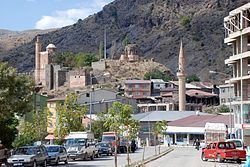Website www.ispir.bel.tr Local time Sunday 3:01 PM | Post code 25900 Area 2,012 km² | |
 | ||
Weather 11°C, Wind NE at 13 km/h, 44% Humidity | ||
İspir (Georgian: სპერი Speri; Armenian: Սպեր Sber or Sper), is a town and district of Erzurum Province in the Eastern Anatolia region of Turkey, on the Çoruh River. The mayor is Osman Çakır (AKP). The district has a population of 30,260 while the town has a population of 11,789.
Contents
Map of %C4%B0spir, 25900 %C4%B0spir%2FErzurum, Turkey
History
İspir is the historical Speri for Georgians and Sper for Armenians.
İspir is known from the 3rd millennium BC. The name Sper is thought by some to be derived from Saspers, a tribe mentioned by Xenophon;
Speri was part of the Georgian Kingdom of Tao-Klarjeti.In the 4th-3rd centuries BC it was organized into a province of the Iberian Kingdom as noted by Strabo, and during subsequent centuries it frequently changed hands between Georgians and Armenians. Alexander the Great sent one of his generals Menon to conquer Speri, but Menon and his forces were defeated and killed. Sper was an Armenian Bagratid domain in the fourth to sixth centuries, a domain whose territory also comprised the Bayburt plain until that was lost to the Byzantines (perhaps in 387).
In the 7th century it passed to the Arab Caliphate; in 885 Bagratuni Kingdom of Armenia. Under the medieval Kingdom of Armenia, it was part of the province of Upper Armenia and was famous for its gold mines. In the 11th century it was conquered by the Seljuqs. Ispir was under the control of the Saltukids till 1124 when the Georgians took over power, governed by Zakare and Ivane Zakarids as a fief. It was recaptured by Mughith ad Din Tughrul, son of the Seljuk sultan Kilij Arslan II, sometime between 1201 and 1225. He build a mosque in the citadel which still survives. It was conquered in 1242 by the Mongols; was regained by Georgian Kingdom during the reign of George V the Brilliant (1314–1346), it remained part of the Kingdom before its disintegration, which then passed into the hands of Georgian Atabegs belonging to the House of Jaqeli; it was conquered in 1502 by Persia and was probably in 1515 taken by the Ottoman Empire from the Georgian ruler of Samtskhe. The valley of Ispir was almost completely Christian in the early 16th century. Muslims would increase in later centuries and eventually become the majority. The town was occupied in 1916 by the Russians during World War I and recaptured by the Turks in 1918.
Historic sights in the town are the citadel, a mosque and church in the citadel (probably 13th century), the originally 13th century Çarsi mosque today's building being a recent structure. The Sultan Melik mosque and Madrasa built in the 13th century, the Madrasa of Kadizade Mehmet built in 1725/26, Kadizade was the Mufti of Erzurum from 1744 to 1759 and his father was the Qadi of Ispir. There is also a tomb with a graveyard containing some Ottoman tombstones.
Climate
The climate is described as Humid Continental by the Köppen Climate System, abbreviated as Dfb.
Economy
As of 1920, coal was being produced in the area.
